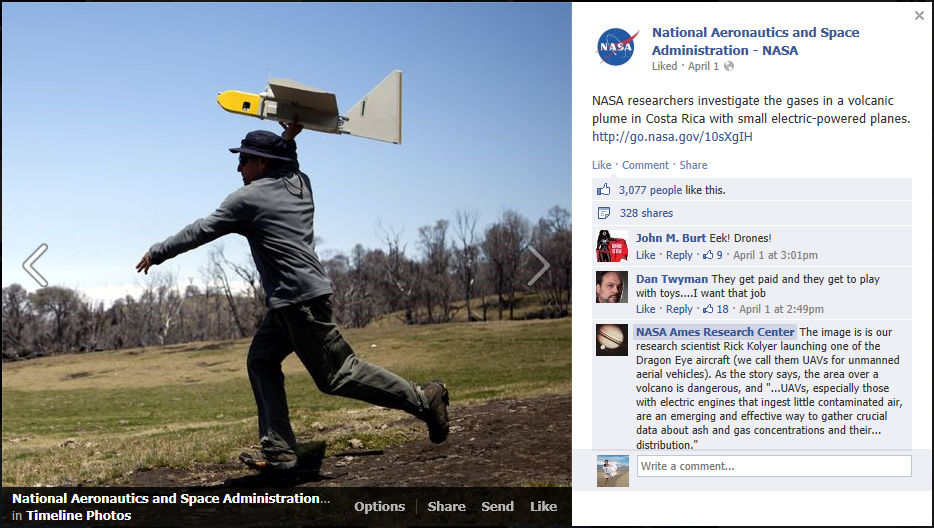13 May 2013
Picture This: Visuals and your Research
Posted by mcadams
By Sarah Charley
A striking image can spark interest in your scientific research, but the picture itself doesn’t need to be informative—in fact, it might be better if it isn’t. That’s one bit of wisdom that veteran science communicators from the news media and science institutions such as NASA shared with an audience Tuesday afternoon at the National Research Council in Washington, D.C.

Interesting images of scientists performing research can draw attention to your research in ways that graphs and charts will not. This photo of a researcher launching a small electric-powered plane to study the gases in a volcanic plume in Costa Rica received 3,078 likes, 329 shares and 89 comments on Facebook. Photo by Justin Linick / NASA.
The visuals that receive the most attention are often not the ones that best explain the research, noted Stephen Cole, the Earth Science lead for NASA’s Office of Communication. “If you just flashed a photograph, think about what imagery would draw people to ask more about it,” he said in an interview. “It’s a different kind of mindset than straight text or scientific information. Think about using visuals that have the purpose of attracting interest, which is different than a graph or chart that provides information.”
Even just a simple picture of a person doing something can draw someone in, Cole added. During his presentation about NASA communications, Cole showed a picture of a scientist launching a small electric powered air plane. “This picture got 3,000 ‘likes’ on Facebook,” he said. “You never know what’s going to go viral.”
Dan Vergano, a science writer from USA Today, agreed about the impact of visuals, and emphasized that in today’s “broadband era,” a one-minute video or enticing image can launch you into telling the story of your science.
Vergano and Cole offered these pointers at a public meeting of the National Research Council’s Board on Earth Sciences and Resources. The Board’s May 7 meeting, on the topic of “Effective communication of Earth Science and Engineering Information,” kicked off with a morning panel about conveying Earth science and engineering information to lawmakers and their staffs on Capitol Hill.
In the afternoon, Cole spoke about NASA communications, followed by a second panel on communicating science and engineering with diverse public audiences. Along with speakers from government agencies and scientific societies, the panel included two reporters—Vergano and Randy Showstack, a staff writer for Eos, the weekly newspaper of the Earth and space sciences, published by the American Geophysical Union (AGU).
Visuals loom larger in the future of Eos. “It’s something we’re working towards as we get a bigger web presence,” Showstack said in an interview. “We are learning to communicate in that way as well…Photos really add something to the story.”
And video takes it all to another level, Vergano noted. “If you want your news to reach general audiences or news organizations, you really should consider options for adding video rather than the old fashioned approach, ‘here’s a copy of my study,’” he said in an interview. “It’s not magic or guaranteed, but including a great video helps.”
— Sarah Charley is AGU’s science writing intern


 The Plainspoken Scientist is the science communication blog of AGU’s Sharing Science program. With this blog, we wish to showcase creative and effective science communication via multiple mediums and modes.
The Plainspoken Scientist is the science communication blog of AGU’s Sharing Science program. With this blog, we wish to showcase creative and effective science communication via multiple mediums and modes.